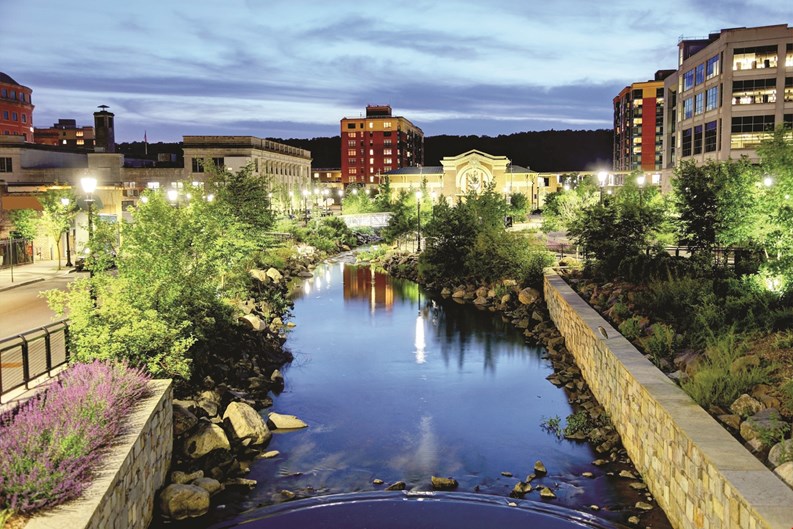After years of dissent, racial and economic woes and political infighting, Yonkers, Westchester County’s largest city and New York State’s fourth most populous town, has transformed itself into a vibrant residential community and a prime destination for those wanting to be close to the hustle and bustle of New York City.
Boasting a population of over 200,000, Yonkers borders the New York City borough of the Bronx and is two miles north of Manhattan at the cities’ closest points. Although Yonkers is home to numerous residential enclaves it can conveniently be divided into four sections; Northeast, Northwest, Southeast and Southwest.
A massive revitalization project is in full swing in Yonkers that is expected to include nearly 1,000 luxury residential units on the waterfront, a minor league baseball stadium and a new Yonkers Fire Department headquarters building. The project is headed by Westchester County developer Louis R. Cappelli, Struever Bros. of Baltimore, and New Jersey's Fidelco Realty.
Thanks to daylighting (the restoration of rivers that have been covered up by concrete) on November 15, 2011, waters began to flow above ground in Yonkers for the first time in 90 years. With the aboveground riverbed more than 13,775 square feet of aquatic habitat including a tidal pool and two freshwater pools have been recreated. The project has enormous ecological, economic and cultural significance for the city.
Dutch Treaty
In the mid-1600s, the Dutch West India Company issued the young nobleman Adriaen Van der Donck, a lawyer, scholar and author, a grant to settle the New Netherland colony. Van der Donck was known locally as the Jonkheer, or from the German “jung herr” as “young gentleman.” Over the years the name evolved from the Jonk Herr’s Land to The Younckers, and eventually to the present day Yonkers.
Van der Donck erected one of the first saw mills in America in Yonkers at the junction of the Hudson and Nepperhan Rivers. The location of Yonkers strategically placed along the heavily traveled waterways fostered its development as a major trading center.
American Indians, Dutch and English were among the diverse community of early settlers in Yonkers. The small farm town flourished in the late 1700s and gained a reputation of welcoming emerging businesses, sawmills, gristmills, blacksmith shops, taverns and general stores flourished during this period. The waterfront served as a vital lifeline for commerce and also provided an appealing stop for stagecoaches and sailing vessels, which only increased the area’s popularity.
The first railroad station built in 1848 on the current site of Yonkers Station contributed to additional occupations, trade and the development of the city’s industrial age.
The Village of Yonkers was incorporated on April 12, 1855, at that time extending approximately two miles along the Hudson River with an average width of about one mile and a population of approximately 7,500. Philipse Manor served as the City Hall. On June 1, 1872, the charter establishing Yonkers as a city was signed by New York Governor John T. Hoffman; the first city so designated in Westchester County. By this time, the population had swelled to about 20,000 and was well on its way to the nearly-tenfold number of residents in Yonkers today.
Industrial Boom
Yonkers’ manufacturing base has included the likes of Elisha Otis, known for inventing the first safety elevator that made skyscrapers possible, and the first elevated mass transit system in the world was created by Yonkers inventor J.P.Ackerley. The first street lighting in the United States was introduced in 1861 and in 1888, Scottish-born John Reid built the first golf course, with three holes, in the United States at St. Andrew’s Golf Club in Yonkers. Early in the 20th century, the city was home to brass era auto maker Colt Runabout Company, and also the headquarters of the Waring Hat Company, at the time the nation’s largest hat manufacturer. During World War II, to assist the war effort, businesses such as the Alexander Smith & Son Carpet factory manufactured blankets and tents and the Otis Elevator Factory contributed tanks for the military.
Some of Yonkers’ notable residents over the years have included William Boyce Thompson, copper magnate, C.C. Dula, former head of Liggett & Myers Tobacco Company, Ella Fitzgerald and W.C. Handy, two of the world's most beloved musical figures, and John E. Andrus, head of the New York Pharmaceutical Association. Andrus was a mayor of the city, a U.S. Congressman (1905 to 1913) and philanthropist, whose trust funds helped establish the Julia Dykman Andrus Home for Children, the John F. Andrus Home for Aged and St. John's Hospital.
Some widely known people who worked in Yonkers include John Masefield, poet laureate of England; Charles P. Steinmetz, electrical wizard; Leo H. Bakeland, inventor of Velox paper and Bakelite, and Edwin Howard Armstrong, the inventor of FM radio. On January 4, 1940, Armstrong joined other Yonkers innovators when he transmitted the first FM radio broadcast (on station W2XCR) from the home of Yonkers resident C.R. Runyon.
Aerosmith’s Steven Tyler, actor Jon Voight and tennis player James Blake were born in Yonkers and R&B singer Mary J. Blige, who was born in the Bronx, grew up there. Quite a number of television shows and movies were filmed in Yonkers: on the silver screen includes Catch Me if You Can, Mona Lisa Smile, Big Daddy, A Beautiful Mind and the Preacher’s Wife, and on the tube includes episodes of Fringe, the Following and The Blacklist.
In the 1950s, manufacturers began to abandon factories along the Hudson River waterfront with increased competition from less expensive imports. The Alexander Smith Carpet Mill fell on hard times and closed its doors in 1954, and sadly the Otis Elevator Factory followed suit. With the loss of jobs, Yonkers grappled with its post-industrial identity and became primarily a residential city. Catering to its new suburban population, the Cross County Shopping Center opened in 1954, complete with a hospital in the middle of the mall as well as a rooftop helipad. A few of the inaugural stores in the mall included Gimbels, John Wanamaker and F.W. Woolworth.
Certain neighborhoods in the city, such as Crestwood, became popular with wealthy New Yorkers wishing to live outside of the city but not in an entirely suburban environment. These factors, coupled with five parkways and thruways, and a 15-minute drive Manhattan, made Yonkers a desirable location in which to live.
Lost In Yonkers
Yonkers, however, became the center of unwanted media attention in the 1980s after a decades-long struggle with racial discrimination and segregation came to a head after federal judge Leonard B. Sand ruled that the city had engaged in institutional segregation in housing and school policies for over 40 years. The judge tied the illegal concentration of public housing and private housing discrimination to the city’s resistance to ending racial isolation in its public schools. The city appealed the decision and lost and Yonkers schools were integrated in 1988.
Despite its racial tensions, Yonkers has a significant Jewish, Arab, Irish-American, Slavic and Portuguese population. The Broadway plays Hello Dolly! and Lost in Yonkers both take place within the city’s Jewish community.
Yonkers is home to many attractions including the Empire City Casino, Yonkers Raceway, the Hudson River Museum, the Science Barge and a well-respected university Sarah Lawrence College.
While many sections of the four-and-a-half mile waterfront remain abandoned, many new condominiums such as the Scrimshaw House, a condominium in an old power plant, and Hudson Park, a luxury residential community next to a Metro-North train station, have given new life to the city’s renewal. Commuters attracted by the half-hour New York City commute have found Yonkers a great place to call home.
Christy Smith-Sloman is a New York-based freelance writer.
—If You're Thinking of Living in..Yonkers, NY—
Demographics
Area: 18.1 square miles
County: Westchester
Area Code: 914
Zip Codes: 10701-10705, 10707, 10708, 10710
Population (2010): 195,976
Density: 10,827.4 people per square mile
Demographics (2010): White 55.8% - Black 18.7% - Other Races 14.7%-Asian 5.9% -
Median Household Income (2009) $53,075
Estimated Per Capita Income (2009) $28, 702
Estimated median house or condo value (2009) $429, 800
REPRESENTATIVES
Mayor: Mike Spano (D) • (914) 377-6300
Governor: Andrew M. Cuomo (D) • (518) 474-8390
U.S. Senators: Charles E. Schumer (D) • (202) 224-6542
Website: www.schumer.senate.gov
Kirsten Gillibrand (D) • (202) 224-4451 • (212) 688-6262
Sources: U.S. Census, City-Data.com, Trulia.com, Wikipedia





Comments
Leave a Comment